博文
介绍华工建设太平洋铁路后裔赵耀贵出版的《美西大陆铁路的无名建筑者》
|
介绍华工建设太平洋铁路后裔赵耀贵出版的《美西大陆铁路的无名建筑者》
黄安年文 2007年4月11日
去年在美国编著《沉默的道钉》大型历史画册时,我曾多次试图与赵耀贵先生取得联系,但是由于阴差阳错,没有能够联系上。去年6月,我在和出版社编辑通信时提到:要“与赵耀贵先生取得联系争取获得工资单照片,如难以做到则用竖在犹他准州奥格登地区的普罗蒙特里丘陵处接轨的纪念碑照片。我们需要尽可能地联系到他本人(billchew@verizon.net),得到他的支持,取得掌握的工资单某些资料的照片。这幅图片资料在我们的画册中是新的内容,而且是筑路工人之孙的新发现。”编辑回信说:“实在联系不上,不出他的图像,用文字内容。”我们已经出版的《沉默的道钉》用的就是文字,而没有图像,这是一个遗憾。
多亏齐鲁电视台孙宁主管等的努力,终于取得了联系,并且转高我的联系地址,她说:“我们在跟赵耀贵联系时,已把您的大概情况和您的个人博客链接给了他,他对您应该已经有了大概的了解。他的中文水平不好,您需要跟他用英文去沟通。还有什么能帮到您的,您尽管说!我们将不遗余力!” 4月7日,我高兴地收到了赵耀贵先生的电子邮件:
Dear Prof. Huangannian,
I am the author of "Nameless Builders of the Transcontinental Railroad". I wasrefered to you by Roget, editor of Qilu television station PRC. You may preview my book from Trafford.com website using the advance search by typing my name William F. Chew and book title. Also manny debates about the history maybe found on the CPRR.org website.
I have search "Google" to find your writing with out sucess. Have you an English version of your wirk/ Please send specific web information. I am a second generation descendent of a Chinese rail worker as my Grandfather Chew-Wing -Qui, 1870 USA. Regreatably I do not read, write and
know a little Cantonize dialect, Sam Yup.
I am honor to contact you and share information by e-mail, hopefully in English.
我已经及时回信给赵先生,感谢他亲自写信,加强我们之间关于华工建设美国西部铁路历史贡献的研究。
赵耀贵(William F. Chew)的祖父赵荣贵1870年来美,担任筑路工人。现年74岁的赵耀贵是美国太空总署的退休工程师。他花了几年时间在加州萨克拉门托铁路博物馆地下室旧纸堆中发现了铁路公司当年付给华工的薪水纪录,他查阅了1864年至1867年的铁路工人原始工资单,找出约1500个华工姓名,扣除部分重复的名字,约有900个姓名是单独的,这些加州华人先驱者的姓名,都收录在他的书中。经过计算他发现薪水较高的是铁匠,每天1.34美元,劳工合约商,每天1.15美元,工头每天1美元,铁路司机、伐木工人都是一元,厨师每天0.66美元;侍者最少,每天0.60美元。扣掉一些“成本”花费,平均每名工人一个月薪水30美元,还要偿还来美的借款、利息、旅费、食物和草药、人头费之后,每月只剩12美元了。他研究了当时工人因筑路受伤和死亡的情形,发现伤亡率远高于其它工程。铁道工程在凿山洞时,每天有20、30人伤亡。在中央太平洋铁路承担的690英里工程中平均每3.2公里死亡3名工人。赵耀贵说,最保守的估计,华工至少死亡1000人,与1882年建巴拿马运河死亡8人,1904年建纽约地下铁死亡50人相比,死亡率远远偏高。他还从1870年的萨克拉门托的报刊上发现了约2万磅人骨的消息,据测算是1200位铁路工人的尸骨,可以确定,当年在铁路修筑过程中,已有大量华工丧命。前不久,他出版了《美西大陆铁路的无名建筑者》一书,为加州铁路史和华人移民史留下了一份宝贵的资产。(参见黄安年编著:《沉默的道钉——建设北美铁路的华工》第90页,五洲传播出版社,2006年10月)
下面是有关赵耀贵先生的部分网上资料:
(一)
华工贡献美西铁路新发现
东方网文 发表:东方网/2005年10月21日;学术交流网/美加华人华侨/2006年3月21日转发
东方网10月21日消息:竖在犹他州波莫托里峰上的纪念碑,诉说华工为美国铁道建筑所做的贡献。
美国经济发展仰赖铁路,为西部铁路出力最多的是华裔先民筑路工人,当年到底有那些华人来美筑路?他们的待遇和生活如何?他们的后人现在何处?筑路工人之孙、华裔退休工程师赵耀贵(Bill
Chew)花了几年时间在加州洛杉矶沙加缅度铁路博物馆地下室旧纸堆中翻找,最近有了新发现。铁道公司付给华工的薪水纪录,成为华工为美国贡献的证据。
赵耀贵的祖父赵荣贵1870年来美,担任筑路工人,但是他一直到1995年沙加缅度铁道博物馆馆长请他帮忙,他才开始对祖父奉献血汗的铁路感兴趣。这几年来,他和意大利裔的太太娜坦莉数度去沙加缅度,在地下室堆积如山的箱子中翻找,最后在中央太平洋铁道公司的薪水纪录中,找到许多手写的华工薪水单。最早的一份是1866年12个月的纪录。
赵耀贵仔细比对之后,整理出头绪。他发现当时一般华工姓名不全,只有Ah You(阿尧)、Ah Fong(阿邝)、Ah
Wah(阿华)、Sein San(先生)等简称,只有一人取了英文名字叫Billy
Yang。这些名字与1870年的人口普查,有半数相吻合。
华工数目每月不同,最多的是4月,有5365人,最少的是元月,约900人。此外,5月、6月、7月、10月人数都有3000、4000人。这些华工因工作不同而薪水不一,赵耀贵计算之后,发现薪水较高的是铁匠,每天1.34美元,其次是劳工合约商(负责找工人的中介),每天1.15美元,工头每天1美元,铁路司机、伐木工人都是一元,厨师每天0.66美元;侍者最少,每天0.60美元。
赵耀贵说,薪水还要扣掉一些“成本”,例如使用铲子扣1.50美元,铁锹2.50美元,手推车5美元,雇工头每天要付15美元租马和拉车,如果损坏要赔30元。平均每名工人一个月薪水30美元,可是还要偿还来美的借款、利息、旅费、食物和草药、人头费,七折八扣之后,每月只剩12美元。
赵耀贵也研究当时工人因筑路受伤和死亡的情形,发现伤亡率远高于其它工程。美国东部铁路修筑雇用的是爱尔兰和欧洲工人,开拓西部因为有印地安人阻挠,加上高山峻岭天气酷热,工人难找,所以多数找华工帮忙。当时很多不知危险的华工被派去安置炸药,有时来不及撤到安全地方就被炸死。赵耀贵发现,铁道工程在凿山洞时,每天有20、30人伤亡。这些华工只能自认倒霉,遗体由各人所属的公所或会馆协助运回家乡。
赵耀贵发现,从沙加缅度到犹他州盐湖城郊区的波莫托里峰(Promontory
Summit)690哩长的铁路,都是中央太平洋铁道公司称为Crokers
Pets的华工所完成。这段铁路虽只占美国横贯铁路的三分之一,可是最艰难,山峰多且高,还要打通15座隧道。有37哩是在严冬建造,工人在18呎深的雪地中,艰难地修路,平均每两哩死亡3名工人。赵耀贵说,最保守的估计,华工至少死亡1000人,与1882年建巴拿马运河死亡8人,1904年建纽约地下铁死亡50人相比,死亡率远远偏高。
赵耀贵也研究这些华人的去向,他参考移民局的旧档案,可是只找到49人。他是筑路工的后代,但是他找不到自己祖父的名字。
赵耀贵目前正在着手写书,希望把华人铁路工人的历史写出来。最近他到南加华人历史学会请求协助,希望各界筑路工人后代能与他联络。
赵耀贵也曾赴中国寻找线索,可是这些华工先祖报喜不报忧,即使在美国吃苦,回到唐山也不愿透露,所以纪录阙如。赵耀贵希望有后人能与他联络,设法为这些人作传。
赵耀贵说,华裔铁路工人忍受各种歧视和艰难困苦,用努力工作来证明他们的优秀,因为他们的牺牲奉献,后来的各地华人移民才有较为平等的地位,“我们不应该让他们的历史被湮灭。”
编辑:澹台明 来源:美国《世界日报》
学术交流网(www.annian.net)/美加华人华侨/2006年3月21日转发
(二)
赵耀贵新书为美铁路华工留名
华声报讯:多种史书记载,1876年9月5日,一条横贯美国南北的大铁路在加利福尼亚州境内落成,3000名华工为修筑这条铁路付出了血汗和生命的代价,在他们身后,绝大多数人没有留下姓名。但是,有一位铁路建设者的后代赵耀贵,收集了近千位华工姓名,出版了《美西大陆铁路的无名建筑者》一书,为加州铁路史和华人移民史留下了一份宝贵的资产。
据美国《星岛日报》报道,现年74岁的赵耀贵是美国太空总署的退休工程师,1870年,他的祖父从中国来到加州修筑铁路,后来这条铁路成为西部开发和加州经济繁荣的大动脉,但是建筑铁路的英雄们,却长久地湮没在历史的烟尘中。为了彰显这段历史,让无名英雄留个名,并肯定华人先驱者的历史贡献,赵耀贵耗费几年时间,查阅了1864年至1867年的铁路工人原始工资单,找出约1500个华工姓名,扣除部分重复的名字,约有900个姓名是单独的,这些加州华人先驱者的姓名,都收录在他的书中,留传后世。
赵耀贵是美国第一个研究铁路华工姓名学的作家和历史学者,透过这项工作,使他有了一些重要的发现。首先,一般美国史书和教科书记载,中国华工修筑加州铁路始于1865年,但是,赵耀贵从1864年的铁路工人薪资单上找到了华工姓名,将华工建筑加州铁路的历史提早了一年。其次,赵耀贵从1870年的沙加缅度报刊上发掘出一条消息,当时发现了约2万磅人骨,据测算是1200位铁路工人的尸骨,可以确定,当年在铁路修筑过程中,已有大量华工丧命。
http://www.people.com.cn/GB/42309/42314/3081676.html
(三)
9位华裔科学家登榜“华美荣誉画像”
(2003-12-24 10:46:03)
来源:华声报
(来源:华声报)
美国南加州华人历史学会为表扬科学、医学和国防方面杰出华人设立的“华美荣誉画像”三年来陆续表扬了近30位优秀华裔科学家,今年又有赵耀贵、夏威廉等9人光荣登榜。
这项计划的发起人马荣贤医师说,这些优秀科学家多半在美国受教育,许多人出身寒微,要克服很多困难,还有人受到种族歧视,但仍保持乐观进取,追求他们的梦想。这些人是我们的导师、朋友、邻居,有些甚至要冒生命危险,才为我们后来的人打开门,以通往更融洽的工作场所。马荣贤把这些人的事迹和照片制成展览板,已在洛杉矶许多中学展出,并将继续到各公私立学校巡回展览。
据美国世界新闻网报道,今年列入表扬名单者有:机械工程师赵耀贵、整型外科专家夏威廉、机械工程师和海军建筑师赵树材、家庭医师李彼珍、生化科学家叶景俊、药学研究专家陈克恢、医师邝如协、生化研究学者刘绍炽、社区医师萧甫怡。他们都在各自的工作领域中取得了令人瞩目的成就。
(华声报)
http://news.xinhuanet.com/world/2003-12/24/content_1246058.htm
(四)
By the summer of 1868, 4,000 workers, two thirds of which were Chinese, had built the transcontinental railroad over the Sierras and into the interior plains. On May 10, 1869, the two railroads were to meet at Promontory, Utah in front of a cheering crowd and a band. A Chinese [and Irish] crew was chosen to lay the final ten miles of track, and it was completed in only twelve hours.
Without the efforts of the Chinese workers in the building of America's railroads, our development and progress as a nation would have been delayed by years. Their toil in severe weather, cruel working conditions and for meager wages cannot be under appreciated. My sentiments and thanks go out to the entire Chinese-American community for its ancestors' contribution to the building of this great Nation.
Image of Chinese Worker at CPRR Tunnel No. 8, above, is a detail of Hart stereoview #204, from the Steve Heselton Collection
"China Labour C. P. R. R. PAY ROLL, NO. 102, for month of March 1865, Received from C. CROCKER, Contractor, Central Pacific Railroad Company, the Sums set opposite our respective names, for services performed, during the month of March 1865"
Early Payroll showing Chinese Workers on the Central Pacific Railroad. Note the signature in Chinese. Courtesy G.J. "Chris" Graves.
William F. Chew, grandson of Chew Wing Qui, a worker of the CPRR and whose maternal grandfather, Woo Sing Jung, was a worker on the Southern Pacific Railroad, has studied the CPRR payroll records at the California State Railroad Museum dating from 1864 to 1867 and written a book, Nameless Builders of the Transcontinental Railroad, reporting his discovery that one thousand Chinese workers are named and their wages and occupations listed. He discovered Payroll Sheets No. 26 and No. 34 dated January and February 1864, recording the first Chinese CPRR workers, headman Hung Wah and foreman Ah Toy (who supervised a crew of 23).
(中央太平洋铁路历史摄影博物馆G.J. "Chris" Graves)
(五)
Nameless Builders of the Transcontinental Railroad
by William F. Chew
157 pages; quality trade paperback (softcover); catalogue #03-1130; ISBN 1-4120-0762-3; US$18.88, C$24.88, EUR15.88, ?10.88
Newly discovered historical facts about the Chinese workers of the Central Pacific Railroad during the construction of the Transcontinental.
Read more!
About the Book????? About the Author????? Table of Contents or Excerpts????? Catalogue Information
About the Book
A historical study of the Chinese railroad workers using data from the Central Pacific Railroad Company payroll records dating from 1864 to 1867, correcting the first date of Chinese by the Central Pacific, and the total number of workers employed, with an explanation of how this estimate was calculated. Nearly one thousand workers are named, listing their wages and occupations, dispelling the notion that all Chinese workers were "coolies".
A synopsis is extrapolated from previously published works along with arguments for and against the data of some historical events, such as Bloomer Cut and Cape Horn. In addition, the building of the Summit Tunnels, and the laying of ten miles of track in one day are detailed. Particular focus is applied to the little known 1,330 Chinese fatalities which occurred while building the western route of the transcontinental, comparing these numbers to the total lives claimed by other major historical construction projects.
About the Author
William F. Chew is a retired aerospace engineer and a descendant of Chinese railroad workers, paternal and maternal grandfathers, Chew Wing Qui, and Woo Sing Jung.
During his forty-five year career as an aerospace engineer, Chew designed and developed critical components for spacecraft travel. From the physical to the cerebral, grandfathers and grandson unwittingly contributed to the transportation industry within the wide range of their positions.
However, Chew's objective in writing this book, is to increase the public's awareness of this pivotal Chinese contribution to the development of America.
Table of Contents or Excerpts
CHAPTER FOUR
Chinese by the Numbers
Research resulting from the payroll records of the Central Pacific Railroad Company becomes significant because it changes currently accepted historical data concerning the initial employment date and total number of the Chinese employed. The original records are archived in the basement of the California State Railroad Museum in Sacramento.1
The basic issues have, from time to time, raised several questions, which I hope to answer with my findings.
1. When and who were the first Chinese employed?
2. What was the maximum number employed?
3. How was this number quantified and qualified?
Employment of the First Chinese Workers
Four of the most popular books about the building of the Transcontinental Railroad overlooked documents that pointed to the exact date of the hiring of the first Chinese railroad workers.
In Chapter Seven, "The Central Pacific Attacks the Sierra-Nevada, 1865," Stephen E. Ambrose writes in Nothing Like It In The World:
In February, a month after Strobridge's all-but-fruitless call for labor, Charlie Crocker had met with him and raised the question of hiring Chinese. He said some twenty of them had worked, and worked well, on the Dutch Flat-Donner Lake Wagon Road. 2
However, the Central Pacific Payroll Sheets No. 26 and No. 34 dated January and February 1864, are the documents that record the first Chinese railroad workers, Hung Wah and Ah Toy,3 who supervised a crew of 23 unnamed workers.
How Many Chinese Worked for the Central Pacific?
It was the railroad's policy that a headman or labor contractor collected pay (in coins) for all the workers in his crew. George Kraus states in his article "Chinese Laborers and the Construction of the Central Pacific," that a method was used by the railroad company to count the total number of workers at the beginning of the morning shift, at lunch, and at the end of the shift to compare the total hours of wages turned in by the gang boss to prevent overpayment. It was said that one could not tell the difference between the Chinese and the Indian workers. Because of this policy it is improbable that the individual names of the actual laborers will ever be known.10
It is commonly reported that peak employment of Chinese workers by the Central Pacific ranges from 10,000 to 20,000. For instance, Kraus states in his book, High Road To Promontory: "The force at work on the road probably averaged from six to ten thousand, nine-tenths of them being Chinese. . ."11
CHAPTER TEN
The Insignificance of Life
It has been said that an ordinary life is as insignificant as a grain of sand is to a desert. This cynical hyperbole may apply to the estimated 1,200 Chinese railroad workers who died from 1864 to 1869 while working on the western route of the Transcontinental. This approximates five Chinese deaths for every three miles of track laid from Sacramento to Promontory Summit, a total of 690 miles. No one knows the exact number of Chinese deaths. Some estimates are as high as 2,000.
Deaths were caused by blasts, avalanches, landslides, rail accidents, falling trees, fatal falls, pneumonia, and freezing to death. But not a single death was reported as being caused from sun or heat stroke, because of the protection that "coolie" straw hats gave the Chinese. The lack of reported deaths from dysentery is attributed to their custom of boiling ground water to make tea while the Irish who drank directly from the streams, suffered from dysentery resulting in many deaths. In general, there was little, if any, news or concern of the Chinese who died. Was it because they were expendable?
Ambrose writes:
Hundreds of barrels of black powder were ignited daily to form a ledge on which a roadbed could be laid. Some of the men were lost in accidents, but we don*t know how many: the CP did not keep a record of Chinese casualties.1
The Chinese volunteered to be lowered in handmade reed baskets 1,400 feet above the riverbed. They drilled holes in the granite and stuffed them with black powder, lit the fuse, and then hoped the men above would pull them up the cliff fast enough to avoid death.
In 1866 the Central Pacific tried using nitroglycerin instead of black powder, because of its greater explosive force.2 However, the use of nitroglycerin was soon abandoned because too many workers were dying from the blast or falling rock. The Central Pacific could not afford to lose workers. Maintaining the schedule of the railroad was more important.
Snowdrifts from 30 to 40 feet in the winter of 1867 caused avalanches burying alive many Chinese whose bodies would not be found until the next spring*s thaw. Many were never found. These Chinese came from the southern part of China, where the climate is semi-tropical. They had never needed nor owned warm clothing until immigrating to the colder regions of the United States. Not acclimated to the extreme cold, many workers died of pneumonia.
No official records of the deaths of Chinese railroad workers were kept.
Thousands of these young men gave their lives in building of the railroad. The dead were never counted, nor have they been memorialized. Some twenty thousand pounds of bones were gathered from shallow graves along the roadbeds and rights of way, according to an 1870 newspaper article quoted in The History of the Chinese in America, by Philip Choy and H. Mark Lai. These bones of about 1,200 Chinese who died in the building of the Transcontinental line were eventually shipped home. But many others lie to this day in unmarked graves in every western state.14
(此图的出处: www.trafford.com/4dcgi/view-item?item=3796...)
http://images.google.com/imgres?imgurl=http://www2.trafford.com/clientimages/aut1412007623.jpg&imgrefurl=http://www.trafford.com/4dcgi/view-item%3Fitem%3D3796%2660195813-25974aaa&h=217&w=150&sz=9&hl=zh-CN&sig2=J6TcEQgkGx7J357JGBNt9Q&start=2&tbnid=APPmugtGOP7W
附图:
1.1865年3月中央太平洋铁路公司的中国劳工工资发放单(黄安年转自美国中央太平洋铁路摄影博物馆)
2.1865年3月中央太平洋铁路公司的中国劳工工资发放单(黄安年编著《沉默的道钉》第90页,五洲传播出版社,2006年10月)
3.竖在犹他州波莫托里峰上的纪念碑(转自美国《世界日报》)
4.Trafford Publishing 网站关于Nameless Builders of the Transcontinental Railroad
by William F. Chew
5.Trafford Publishing 网站关于Nameless Builders of the Transcontinental Railroad一书的介绍
6.Trafford Publishing 网站关于Nameless Builders of the Transcontinental Railroad一书作者的介绍
7.Trafford Publishing 网站关于Nameless Builders of the Transcontinental Railroad一书的目录
8.赵耀贵肖像(http://whoiswho.bm/photos/mulder_william_f_p.jpg)
9.赵耀贵肖像(SCV Historical Society)
10.赵耀贵肖像(SCV Historical Society)
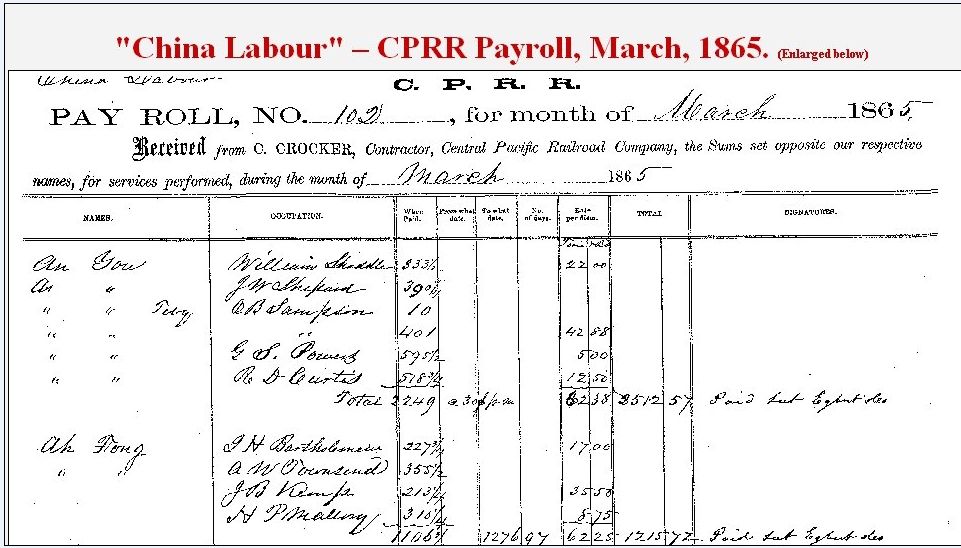
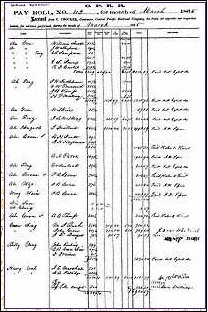


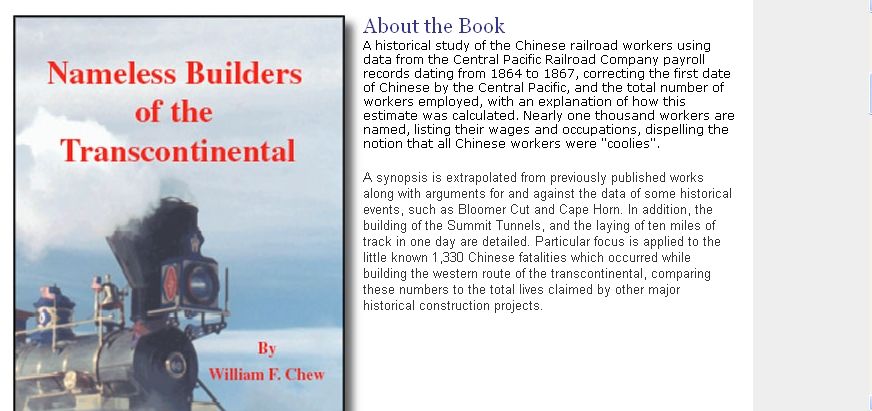

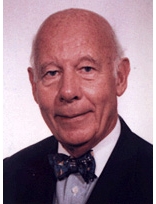
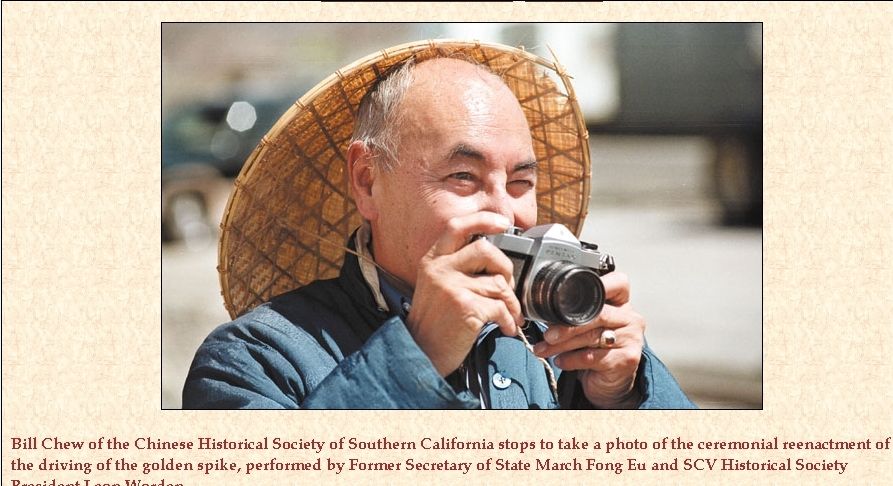

https://blog.sciencenet.cn/blog-415-1311.html
上一篇:清河立水桥东段河床拓宽工程能否使清河变清?
下一篇:天通苑宽带网络技术故障排除后的情况说明了什么